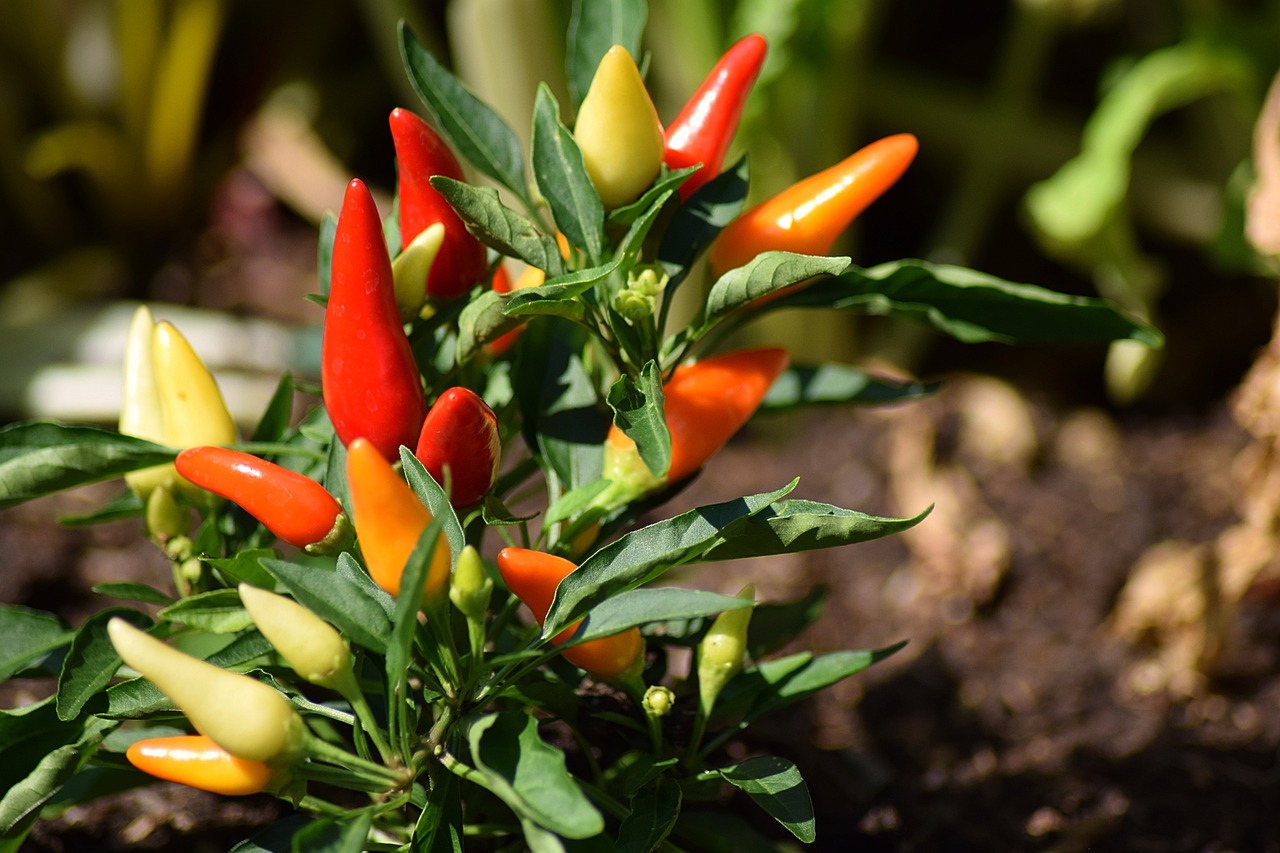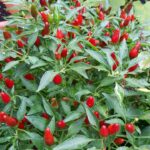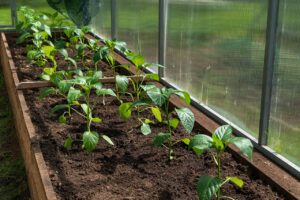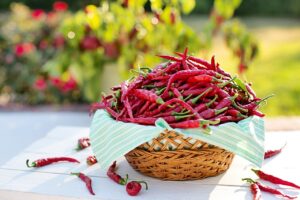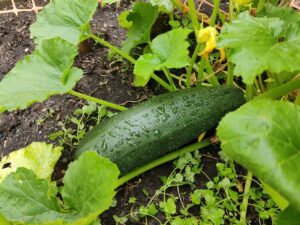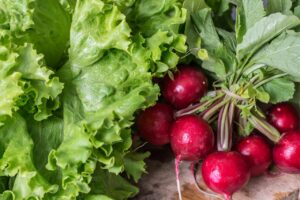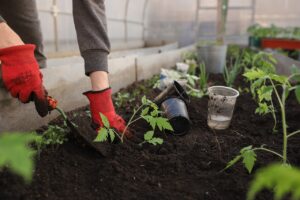Growing Peppers: A Culinary Gardener’s Delight
Learning how to grow peppers is a fantastic way to elevate your home cooking or culinary endeavours, providing fresh, flavorful ingredients straight from your garden. There’s nothing quite like using fresh peppers from my garden in my own cooking. Chili peppers are a popular and versatile crop known for their wide range of flavours, colours, and heat levels. In this comprehensive guide, we’ll cover the entire process of how to grow peppers, from planting seeds to harvesting the fruit. Drawing from my personal experiences and research, I’ve compiled tips and advice to equip you to cultivate a thriving garden, yielding a bountiful harvest you can be proud of.
Types of Peppers
Chili peppers come in a wide range of shapes, sizes, colours, and heat levels. Here are some popular types of chili pepper varieties, each offering its unique characteristics:
Hot Peppers
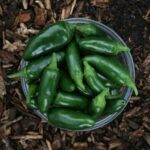
- Jalapeño: A popular, medium-hot pepper with a Scoville heat rating of 2,500 to 8,000. Jalapeños are versatile in the kitchen, used fresh or pickled, and are often stuffed with cheese and other fillings.
- Cayenne: A medium-hot pepper with a Scoville rating of 30,000 to 50,000, cayenne peppers are commonly dried and ground into a versatile spice that adds heat to various dishes.
- Habanero: Known for their fiery heat, habaneros have a Scoville rating of 100,000 to 350,000. They come in various colours, including orange, red, and chocolate brown. Use habaneros sparingly in salsas, hot sauces, and other spicy dishes.
- Caribbean Red Chili Peppers: A fiery and flavourful variety of hot pepper originating from the Caribbean region. These vibrant red peppers pack a powerful
Habanero Peppers punch with a Scoville heat rating of 300,000 to 445,000. Typically smaller in size and lantern-shaped, they are perfect for adding heat to sauces, salsas, and traditional Caribbean dishes. For gardeners seeking a spicy challenge, the Caribbean Red Chili Pepper is an exciting and rewarding choice to cultivate.
- Poblano: Mildly spicy, with a Scoville rating of 1,000 to 1,500, poblanos are popular for roasting and stuffing. When dried, they are called ancho chilies and are used in mole sauces.
- Serrano: Small, slender, and slightly hotter than jalapeños, serranos have a Scoville rating of 10,000 to 23,000. They are often used in salsas and other Mexican dishes.
- Bird’s Eye (Thai Chili): These tiny, intensely hot peppers pack a punch, with a Scoville rating of 50,000 to 100,000. They are a staple in Thai
Bird’s Eye Peppers and Southeast Asian cuisine, adding heat to curries, stir-fries, and sauces.
- Carolina Reaper: Currently recognized as the world’s hottest pepper, the Carolina Reaper has a Scoville rating of 1,400,000 to 2,200,000. This pepper is not for the faint of heart and should be used with extreme caution in culinary applications.
- Ghost Pepper (Bhut Jolokia): Once considered the world’s hottest pepper, the ghost pepper has a Scoville rating of 855,000 to 1,041,000. It is an essential ingredient in Indian cuisine and is used sparingly in hot sauces and other dishes.
- Sweet Banana Pepper: These mild, sweet peppers are perfect for those who prefer less heat, with a Scoville rating of 0 to 500. They are often pickled, used in salads, or cooked in various dishes.
Sweet Peppers
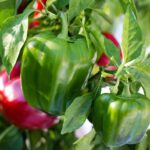
- California Wonder peppers: A popular variety of sweet bell pepper known for their large, blocky shape and thick walls. These versatile peppers mature from green to a bright red colour and are packed with flavour and nutrients. Ideal for stuffing, grilling, or adding to salads and stir-fries, California Wonder peppers are a reliable and easy-to-grow addition to any home garden.
- Golden California Wonder peppers: A striking variety of sweet bell pepper boasting a vibrant golden-yellow hue when fully ripe. Similar to their red counterparts, these peppers feature a large, blocky shape and thick walls, making them perfect for stuffing, grilling, or adding a pop of colour to salads and stir-fries. Easy to cultivate and rich in flavour, Golden California Wonder peppers are a delightful and eye-catching choice for any home garden.
How to Grow Peppers from Seed
The first step in learning how to grow peppers is selecting high-quality seeds from a reputable source, which is essential for a successful crop. In the following step-by-step guide, we’ll cover the process of germinating and growing peppers from seeds:
- Fill seed trays or small pots with a moist, well-draining seed-starting mix.
- Plant seeds about 1/4 inch deep and cover lightly with soil.
- Place the seed trays in a warm location (70-85°F) to encourage germination. Pepper seeds typically germinate within 7-14 days, but some varieties may take longer.
- Keep the soil consistently moist but not waterlogged, and provide bright, indirect light.
How to Plant Peppers: Nursery Plants & Transplanting Pepper Seedlings
Whether you’re starting with pepper plants from a nursery or transplanting your own seedlings, the planting process is similar. Follow these steps to ensure a successful transplant:
- Choose healthy plants with strong stems and green leaves, or wait for your seedlings to develop at least two sets of true leaves.
- Harden off your pepper plants or seedlings by gradually exposing them to outdoor conditions over a week to 10 days.
- Select a planting location that provides at least 6-8 hours of sunlight, as peppers need plenty of sun to thrive.
- Amend the soil with compost or aged manure to improve drainage and fertility.
- Space the plants or seedlings 18-24 inches apart in rows 24-36 inches apart.
- For nursery plants, dig a hole slightly larger than the root ball of the pepper plant. Gently remove the plant from its container, taking care not to damage the roots. For seedlings, dig a hole the same depth as the seedling container.
- Place the plant or seedling in the hole, ensuring that the top of the root ball is level with the surrounding soil (for nursery plants) or at the same depth as in the seedling container (for seedlings). Fill in the hole with soil and gently firm it around the base of the plant.
- Water the plant or seedling thoroughly to help settle the soil and establish the roots.
Pepper Plant Care
Proper pepper plant care is essential to a successful harvest. Here are some tips to keep your plants healthy and productive:
- Water consistently, providing about 1-2 inches of water per week. Avoid overwatering, as this can lead to root rot and other issues.
- Apply a balanced, slow-release fertilizer at planting time and again when the plants start to produce fruit.
- Monitor for pests, such as aphids, flea beetles, and pepper maggots. Employ organic or chemical controls as needed.
- Stake or cage taller pepper varieties to provide support and prevent fruit from touching the ground.
Growing Peppers in Containers
If you have limited outdoor space or simply prefer container gardening, learning how to grow peppers in containers can be a rewarding alternative. With the right approach, you can successfully cultivate a variety of peppers in pots or other containers. Here are some tips for growing peppers in containers:
- Choose the right container: Select a container with a minimum depth of 12 inches and a similar diameter to accommodate the pepper plant’s root system. Ensure that the container has adequate drainage holes to prevent root rot.
- Use high-quality potting mix: Fill the container with a well-draining, high-quality potting mix. Avoid using garden soil, as it can become compacted and limit root growth.
- Select suitable pepper varieties: Some pepper varieties are better suited for container gardening than others. Look for compact or dwarf varieties that won’t outgrow their containers. Examples include Bird’s Eye, Patio Fire, Cajun Belle, and Jingle Bells.
- Provide ample sunlight: As with in-ground pepper plants, peppers grown in containers need at least 6-8 hours of sunlight daily. Place your containers in a sunny location or use a grow light to supplement natural light.
- Water consistently: Container-grown peppers typically require more frequent watering than those grown in the ground. Monitor the soil moisture regularly and water when the top inch of soil feels dry to the touch.
- Fertilize regularly: Peppers in containers may need more frequent fertilization, as nutrients can be washed away with each watering. Use a balanced, slow-release fertilizer or a liquid fertilizer formulated for vegetables, following the manufacturer’s instructions.
- Stake or cage if necessary: Some pepper plants may require support as they grow. Use stakes or small cages to help keep your plants upright and prevent them from toppling over.
Harvesting and Storing Your Peppers
When your peppers have reached their mature size and colour, it’s time to harvest. Follow these steps to ensure a bountiful harvest:
- Use clean, sharp scissors or pruning shears to cut the peppers from the plant, leaving a short stem attached to the fruit.
- Handle the peppers gently to avoid bruising or damaging the fruit.
- Harvest peppers regularly to encourage continuous production.
To store your peppers, follow these guidelines:
- Store fresh peppers in the refrigerator for up to two weeks. Place them in a plastic bag or container with a paper towel to absorb excess moisture.
- Freeze peppers by cutting them into desired-size pieces and spreading them out on a baking sheet. Freeze until solid, then transfer to an airtight container or freezer bag for long-term storage.
- Dry peppers by hanging them in a well-ventilated area, using a dehydrator, or placing them in an oven on the lowest setting.
Common Questions Answered:
How Long Does it Take to Grow Peppers from Seed?
The time it takes to grow peppers from seed depends on the variety and growing conditions. Generally, pepper seeds germinate within 7-14 days, although some varieties may take longer. After transplanting the seedlings, it usually takes about 60-90 days for the plants to mature and start producing fruit. In total, you can expect the entire process to take approximately 70 to 110 days from sowing the seeds to harvesting your peppers. Remember that factors such as sunlight, temperature, and soil quality can impact the overall growth timeline.
How Long Does it Take for Bell Peppers to Grow?
The time it takes for bell peppers to grow depends on the variety and growing conditions. On average, bell peppers require 60-90 days to reach maturity after transplanting. However, this timeframe may vary depending on sunlight, soil quality, and temperature. Be patient and monitor your plants closely to ensure they receive the proper care and conditions needed to thrive.
How Much Sun Do Peppers Need?
Peppers are sun-loving plants, requiring at least 6-8 hours of direct sunlight daily to grow and produce fruit. Choose a planting location that receives full sun and is protected from strong winds, which can cause damage to the plants. If you’re growing peppers in containers or have limited outdoor space, consider using a grow light to supplement natural sunlight.
How Tall Do Pepper Plants Grow?
The height of pepper plants can vary significantly depending on the variety and growing conditions. Generally, pepper plants can grow anywhere from 1 to 6 feet tall. Most commonly grown varieties, such as bell peppers and jalapenos, typically reach a height of 2 to 3 feet. Smaller, compact varieties suitable for container gardening can be as short as 1 foot, while some heirloom or specialty types may grow taller, reaching up to 6 feet in height.
Pepper Companion Plants
Incorporating pepper companion plants in your garden can not only boost the growth and overall health of your pepper plants, but also help deter pests, attract beneficial insects, and create a more visually appealing garden. Companion planting is a gardening technique that involves planting different species together, which can benefit each other in various ways. Here are some excellent companion plants for peppers and the advantages they offer:
- Basil – This fragrant herb not only improves the flavour of peppers but also repels pests such as aphids, spider mites, and whiteflies. It’s also thought to increase pollination by attracting bees and other beneficial insects.
- Marigolds – These bright, cheerful flowers are known for their ability to deter pests like nematodes and whiteflies. They also attract beneficial insects, such as ladybugs and lacewings, which can help control aphid populations.
- Onions – Planting onions near your peppers can help repel pests like aphids and thrips, thanks to their pungent aroma. Additionally, their dense foliage can help suppress weed growth, reducing competition for nutrients and water.
- Tomatoes – Tomatoes and peppers share similar growing conditions, making them good companions in the garden. They can be interplanted to save space and make the most of available resources. However, it’s important to note that they are also susceptible to some of the same diseases, so proper crop rotation and pest management are essential.
- Chives – These versatile, onion-flavoured herbs can help deter aphids and other pests while also providing a flavorful addition to your meals.
Conclusion
Mastering the art of how to grow peppers can be an incredibly rewarding experience, providing you with a diverse and flavorful bounty. By understanding the essentials of how to plant peppers and implementing proper care techniques, you can ensure that your garden thrives. Additionally, incorporating pepper companion plants can improve your garden’s overall health and productivity while creating a visually appealing space.

